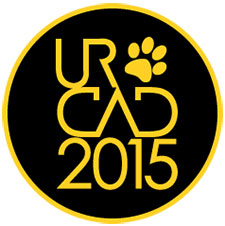Thinking Out Loud
URCAD 2015 celebrates undergraduate student experiences in research and creative achievement.
As a transfer student from Montgomery College, Trevor Blank ’05, American studies, was fascinated by the history and folklore of a structure that once stood on UMBC’s campus: the Hillcrest Building, constructed in 1921 as the Spring Grove State Hospital. A different person might read a book about their new interest and move on, but Blank chose to write the book on it instead.
His research on the site as an undergraduate carried through to his graduate studies at Indiana University’s Folklore Institute and Pennsylvania State University, Harrisburg, and produced a co-authored volume on the hospital facility. Today, Blank is an assistant professor of communication at SUNY Potsdam and author or editor of seven books, including The Last Laugh: Folk Humor, Celebrity Culture, and Mass-Mediated Disasters in the Digital Age (University of Wisconsin Press 2013). On April 22, 2015, UMBC welcomes him back to campus to reflect on his path as a researcher as featured speaker for the 19th annual Undergraduate Research and Creative Achievement Day (URCAD).
Diane M. Lee, vice provost and dean of undergraduate education, shares that UMBC began organizing URCAD in the late 1990s to highlight the particularly robust research opportunities that UMBC undergraduate students experience. She expects this year’s participating students will find inspiration and insight in Blank’s remarks. “Dr. Blank’s story is a wonderful reminder about the value of the distinctive undergraduate experience UMBC provides,” she explains.
For Janet McGlynn, director of communications and outreach for the Office of Undergraduate Education, URCAD itself provides students with an essential piece of research training: a foundation in research communications. She shares, “Undergraduate researchers and URCAD presenters who go on to graduate school find that they are well prepared to present their work in department meetings or larger symposia. They know how to make a poster and how to talk about their work to either a general or an expert audience.”
URCAD 2015 features over 200 presentations, including artistic performances, film screenings, and oral and poster presentations, across all disciplines. A few highlights:
Paul Tschirgi ’15, visual arts, and Courtney Tyler ’15, dance, filmed original choreography and animated the videos to allow viewers to experience the performances using game controllers.
JR Smith ’15, computer science; Savannah Myers ’16, visual arts; Paul Tschirgi ’15, visual arts; Ben Walsh ’15, computer science; Samantha Carestia ’15, visual arts; Brandon Cole ’15, visual arts; Celeste Haskett, ’16, visual arts; and Jeff Hurd ’15, computer science, created an educational video game, Bandit, where the player becomes a fox running through Baltimore as the Pratt Street Riot breaks out during the American Civil War.
Jack Neumeier ’16, interdisciplinary studies; Jasper Dudley ’17, design and interdisciplinary studies; and Mai Huong Vu Huynh-Teage ’16, design, constructed “The Kraken,” an entry for the Kinetic Sculpture Race that explores the effect of pollution on aquatic ecosystems.
Julie Norton ’15, biological sciences; Kevin Liao, ’16, biological sciences; Mimi Way, ’15, biological sciences; and Brittnie Prakash ’15, biological sciences, isolated the Bacillus bacteriophage from soil found in central Russia.
Shannon Mitchell ’15, American Studies and psychology, analyzed geographic differences in newspaper coverage of the 2012 Trayvon Martin case.
Nnamdi Edokobi ’15, biochemistry and molecular biology, examined environmental and other risk factors impacting disparate rates of breast cancer among Baltimore City populations.
Hunter Somerville ’15, computer engineering; Kevin Sears ’15, computer engineering; Michael Warren ’15, mechanical engineering; and Sergei Grishin ’15, computer engineering, worked to develop a device that can automatically control airflow, increasing HVAC efficiency.
Each of these projects represents months or years of independent and collaborative research and creative production.
Savannah Myers is enthusiastic about showcasing her group’s interdisciplinary work on the video game Bandit, which teaches players about the Pratt Street Riots. She shares, “I’m excited to show what can be accomplished with 3D animation and a group of both artists and programmers at the student level. Often times people don’t realize how much work and research goes into creating interactive experiences.”
The interdisciplinary team behind “The Kraken” emphasizes the labor and rewards of their collaborative experience as well, which they describe as a demonstration of best practices for arts integration in STEM. The team members also see the project as a reflection of their values as researchers, artists, builders and designers. For Mai Huong Vu Huynh-Teage, creating “The Kraken” as an entry into Baltimore’s Kinetic Sculpture Race is an opportunity to bring greater attention to “pollution, environmental change and conservation.” It’s appropriate that the team’s “sneak peek” demonstration of the moving sculpture at URCAD coincides with Earth Day.
For a full list of URCAD presenters and abstracts, see the URCAD website. Support student presenters and get a glimpse of research projects throughout the day on social media via #URCAD.
(04/21/2015)
© University of Maryland, Baltimore County 1000 Hilltop Circle, Baltimore, MD 21250 410-455-1000

